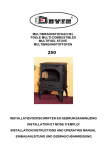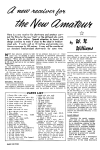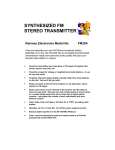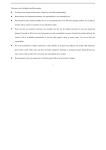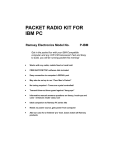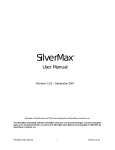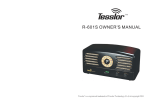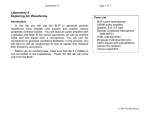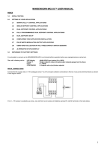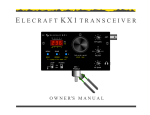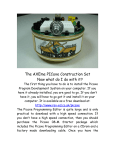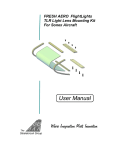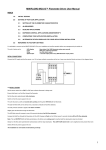Download MFJ-8100 World Band Receiver
Transcript
MFJ-8100 World Band Receiver MFJ-8100 World Band Receiver Table of Contents For Beginners Just a Bit of History Page 2 Back to Today and the Future Page 3 A Simplified Explanation of How it Works Page 3 For Experienced Hams, Enthusiasts and Engineers Page 4 Receiver Controls and Connections Page 6 Understanding and Using the Regeneration Control Page 7 Tuning SSB Voice Signals Using and Enjoying Your Receiver Page 9 Setting Up A Useful Shortwave Antenna Page 9 Your Receiver Audio Circuit Page 10 About the 5 Tuning Ranges of Your Receiver Page 11 Shortwave Listening in General Page 12 In Case of Difficulty Page 12 Notes for Radio Hams & Experimenters Page 13 Conclusion 14 Some Helpful Terms & Abbreviations 15 Sample SWL Log Page Page MFJ-8100 Parts List 18 PC-Board View Page Schematic Diagram of MFJ-8100 Receiver Page 20 1 Page 2 Page 8 Page Page 17 Page 19 MFJ-8100 World Band Receiver Instruction Manual written by Dan F. Onley, K4ZRA Copyright 1993 by MFJ Enterprises, Inc. All Reserved. 2 Rights MFJ-8100 World Band Receiver For Beginners You're about enjoy a versatile shortwave receiver which employs a circuit concept that is as classic as the 1920's but which uses modern engineering that takes advantage of the advanced capabilities of today's electronic components. This shortwave radio is designed to let you listen to a great variety of international broadcasts. You can choose from five different frequency "bands'' so that you can count on hearing SOMETHING at any hour of day or night. Also, this receiver lets you hear a generous sampling of ham radio signals (both Morse code "CW'' and voice "SSB'' communications), plus many other government and commercial transmissions. Just a Bit of History The "regenerative receiver'' moved the world of radio reception and broadcasting beyond the limits of crystal sets useful only for hearing a strong local signal. For over a decade, these magical, whistling, squawking, glowing boxes were the norm for home listening as well as for the first generation of radio hams. Receiver design evolved swiftly. The "superheterodyne'' became the norm during the 1930's. Regenerative receivers, often called "Gennies,'' were left to tinkerers and beginners. Even though these receivers were simple and quite sensitive, they had a number of shortcomings: instability, touchiness, difficulty in separating strong stations, a tendency to generate interference to other receivers, and a general reputation for making odd sounds that resembled everything from pigs to motorboats. However, the sheer SIMPLENESS of the regenerative circuit remained attractive to experimenters and beginners. In fact, as recently as the 1960's, one company marketed a $14 kit for building a complete transceiver using only one vacuum tube: half of the tube served as a regenerative receiver, and the other half was a low-power crystal-controlled transmitter. In addition, many thousands of engineering careers as well as ham radio licenses were launched with the building of "my first shortwave radio'' from do-it-yourself regenerative 3 MFJ-8100 World Band Receiver receiver kits offered by the major radio companies of several decades ago. (The fondest dream BACK THEN of most of these radio builders was to be able to afford to move up to a "superhet communications receiver.'' Their fondest memory TODAY is that very first receiver kit.) From the late 1970's through the '80's, as consumer electronics and new ham radio equipment became more sophisticated so very rapidly, interest declined not only in regenerative receivers, but also in kit-building and even in shortwave radio listening. One or two generations of Americans simply missed out on the thrill and satisfaction of building AND UNDERSTANDING a simple radio set which could receive signals from anywhere in the world. Back to Today and the Future! Your MFJ 8100 is a much better receiver than the "classic'' radio sets which attracted several generations of Americans to the excitement of radio and electronics. In fact, its basic performance is superior to many of the simplest superhet receivers which were considered such a great step beyond one's first regenerative set. The reason why this receiver works so well is because there is much more precision in today's engineering designs and the manufacturing of electronic parts. We looked carefully at the practical problems associated with yesteryear's technology, and we used TODAY'S know-how and components to solve the problems. A Simplified Explanation of How It Works When you're ready, please explore the technical explanation of your receiver in "Introduction No. 2.'' In the meantime, you can peek at the schematic diagram and picture the receiver in three basic sections: A. Detector-Oscillator (Q1,Q2) B. RF amplifier (Q3) C. Audio amplifier (IC1) 4 MFJ-8100 World Band Receiver To put it very simply, a detector converts radio energy from an antenna into audio energy, i.e., a sound which you can hear. A detector can be as simple as a crystal diode, which is the heart of the simple "crystal radio.'' If you've ever heard unwanted radio signals on a stereo, telephone, PA system or intercom, you can assume that some part of those devices has acted as a detector to convert a nearby CB, taxi or broadcast signal into intelligible sound. (This process of detection is also referred to as demodulation.) In the feedback thing. following explanation, the words regeneration, and oscillation all mean approximately the same By itself, a detector can interpret or demodulate only very strong signals such as a nearby AM radio station. However, the process of regeneration can make a detector MUCH more sensitive by turning the detector into an "oscillating amplifier.'' The regeneration circuit repeatedly feeds the detected signal back to the input which boosts its strength many hundreds of times. This feedback process must be carefully controlled, which is the function of the regeneration control. The frequency of oscillation is determined by the choice of inductors (bandswitch) and the setting of the tuning capacitor. If the oscillator is tuned to 10.1 MHz, for example, any radio signal on that frequency will be boosted and detected in the regeneration process. The resulting output from transistor Q2 is a low-level audio signal which is boosted to comfortable listening level by the LM386 integrated circuit amplifier. The RF amplifier serves two purposes. It boosts the RF signals from the antenna to the detector, and it minimizes the amount of oscillator RF going back out to the antenna. Again, we hope you'll also look at the somewhat more technical explanation of how your 8100 Receiver circuit works. If any terminology used in this book is unfamiliar to you, please check the Glossary. For Experienced Hams, Enthusiasts or Engineers 5 MFJ-8100 World Band Receiver Why use a REGENERATIVE circuit for a kit new for the 1990's? A fair question, but the MFJ-8100 is not like any regenerative HF receiver you've ever used before! Our GOAL determined the design and circuitry of this receiver. We wanted the following features: GOOD reception of BOTH shortwave AM and CW-SSB Ease of kit-construction for newcomers Reasonable price A quality look and feel Relatively simple circuit No critical alignment requirements Low parts count, yet not dependent on specialty IC's Purposeful choice of tuning ranges for SWLing anytime. Satisfactory AM-CW-SSB listening and circuit simplicity were our primary goals. Despite the popularity of NE602-type "direct conversion'' circuits among today's experimenters and some kit vendors, direct conversion is NOT satisfactory for ENJOYABLE listening to AM shortwave broadcasts. Merely nulling the carrier does not result in true listenability. Similarly, a multi-band superhet with BFO could not fit our goals of simplicity and economy. To meet our goals, we chose to refine the regenerative concept as much as possible, using contemporary design concepts and component characteristics. Our first goal was to "tame'' the regeneration process itself to minimize the instability and unwanted oscillations so typical of traditional regenerative circuits -- and so that even a beginner can enjoy and understand the use of the Regeneration Control. The result of our re-design is an HF SWL receiver with better performance than many low-end factory-built superhets of yesteryear. Some highlights of our design efforts: __ Significantly reduced RFI back through antenna, a chronic regen receiver shortcoming, through use of carefully designed RF amplifier stage. __ Effective RF filtering between detector and audio sections of the receiver. __ Simplified L-C tuning: notice that there are 5 band switch positions but no coil taps or second windings! __ Elimination of antenna trimmer so critical in most regenerative designs. We replaced the traditional trimmer 6 MFJ-8100 World Band Receiver with an RF gain pot that has little effect on frequency or regeneration. __ Manageable, "tame'' regeneration control circuit. Regeneration begins smoothly with no pop and has a comfortable adjustment range. The result, we think, is a receiver design which bridges the classic simplicity of regeneration to the performance demands of the 1990's. Here's how we did it: In brief, the circuit uses RF regeneration and high levels of DC feedback. Notice that the antenna is coupled directly to the source of RF amplifier FET Q3 rather than through the L-C tuning network. Direct coupling of the drains of Q1 and Q3 isolates the L-C circuit from the antenna input, enhancing stability and greatly minimizing RF oscillator output to the antenna. Such RFI has been a serious problem in traditional regenerative circuits which permitted the oscillating detector to behave as an unstable but potent QRP transmitter. R4 reduces the Q of L1 (10 uH) for smoother regeneration. The SW1 bandswitch selects a combination of simple inductors. For example, the total inductance for Band A is L1+L2+L3+L4+L5. The inductance for Band E is only L5. And so forth. Air variable C1 uses its 50 pF range and mechanical vernier reduction to provide smooth "bandspread'' in parallel with C3 and trimmer C5 which perform the traditional "bandset'' function. Trimmer pot R20 ensures adjustability for smooth regeneration over all tuning ranges, regardless of individual FET characteristics. C17, C9, C10 and R9 form a low pass filter to block RF from the audio amplifier and provide basic audio filtering. Volume Control R2 varies OUTPUT rather than low-level input to the LM386 audio amplifier. This approach further isolates the RF stages from variations in the audio section. The LM386 (IC1) circuitry employs all recommended options for maximum gain and protection from self-oscillation. 7 MFJ-8100 World Band Receiver To prolong useful battery life, R13 limits current draw by the LED (CR1) to minimum reasonable visibility as an on-off indicator. 8 MFJ-8100 World Band Receiver RECEIVER CONTROLS AND CONNECTIONS Most of the controls are self explanatory. However, it is very important to understand the correct use of the Regeneration Control and the two internal trimmer adjustments of the receiver. BANDSWITCH (SW1) This quality rotary switch selects any one of the 5 tuning ranges from A to E indicated on the tuning scale. TUNING (C1) The Tuning knob controls an air-variable capacitor (C1) which also has a built-in 6:1 vernier reduction drive to which the dial pointer is attached. This reduction permits very smooth tuning. The frequency markings on the dial scale must be understood to be approximate due to the 10% tolerance ratings of the fixed inductors (L1 through L5). PUSH SWITCH (SW2) AND L.E.D. INDICATOR (CR1) While the purpose of the on-off switch and LED is obvious, remember to turn your receiver OFF when not in use. A weakened battery degrades receiver performance. REGENERATION (R1) Because understanding and controlling regeneration is at the heart of your receiver's performance, we've provided a separate section on its use. In brief, it controls receiver sensitivity and adjusts between AM broadcasts and CW-SSB. VOLUME (R2) This potentiometer performs the normal function of any volume control. Of interest to the technically-minded, it controls the output of the LM386 audio IC, rather than the input, which enhances the stability of the regenerative detector. RF GAIN (R9) This trimmer potentiometer is adjustable with a small screwdriver. Maximum gain is clockwise when viewing the rear panel. A good normal setting is 3/4 of its full rotation. If you are using a marginal antenna (5 to 10 feet of wire indoors), keep R9 at its maximum setting. If you are using a very good antenna (a long, high outdoor wire or ham antenna), keep R9 at about 2/3 or so of its range. If your listening interests require frequent RF gain adjustments, install an external 10K control in series with your antenna. 9 MFJ-8100 World Band Receiver REGENERATION Ordinarily, construction transistors regeneration Construction RANGE TRIMMER (R20) this trimmer is adjusted only after kit or in the unlikely event that any of the FET are replaced. This adjustment assures smooth over all five of the tuning ranges. See Phase 5. DIAL CALIBRATION TRIMMER (C5) This one-time internal adjustment is made with a miniature screwdriver in order to assure that the frequency markings on the front panel are as accurate as reasonably possible. EARPHONE JACKS (J2,J3) These two jacks accept 1/8'' (3.5 mm.) STEREO plugs as used in "Walkman'' type headphones or mini-speaker systems. The audio output is monaural; the two jacks are wired in parallel to permit the use of two headphones. (NOTE: if a mono 1/8'' plug is used for any reason, it must not be pushed all the way in, or it will short out the audio. ANTENNA CONNECTOR (J1) This binding post permits easy hookup of any wire, or a banana plug may be inserted in its end. 10 to 20 feet of ordinary hookup wire (also called "bell wire'') provides good basic reception, even when installed indoors. See the section on Antennas in this book for more information. GROUND CONNECTION For casual operation, a ground connection is optional. However, a wire from this connector to a ground rod or cold water pipe will reduce unwanted noise and interference from nearby electrical devices or AC wiring and may boost receiver sensitivity. Attach the wire between the two washers, then tighten the wing nut. UNDERSTANDING & USING THE REGENERATION CONTROL In theory, your receiver's Regeneration Control adjusts the level of feedback or self-oscillation of the FET detector section (Q1 and Q2). In PRACTICE, this control is like a "joystick'' for managing and optimizing receiver performance. Your ability to handle this "joystick'' saves you many dollars over today's cost of receivers which perform similar functions "automatically.'' In fact, you might even get more control over receiver performance in varying situations than may be possible with more elaborate receivers. 10 MFJ-8100 World Band Receiver With the control turned fully to the left (counter clockwise), the receiver is virtually silent. "Regeneration'' begins at a certain point as you turn the control clockwise. The exact point varies not only from band to band but even as you tune within a given band. Regeneration begins as an audible increase in background noise followed by a soft hiss. The hiss, or any signals that may be on frequency, increases as you continue to turn clockwise. If you go too far, the signal becomes distorted, or the receiver begins to squeal (oscillate). Always use the LEAST amount of regeneration necessary for good reception of a given signal. As a rule, the best reception of AM shortwave broadcast signals occurs just BEFORE full regeneration. If you hear a whistle (carrier) along with an AM signal, turn the control back slightly until the carrier disappears. When there are a number of very strong shortwave AM broadcasts in a given band, such as is common in the early evening, you will find it possible to tune them in one after the other with the regeneration control set "way back'' and requiring virtually no adjustment. In other words, you would tune from station to station just as if using any other type of shortwave set. When the receiver is adjusted for good AM reception, CW signals will sound like hisses. Advancing the regeneration control slightly will bring in the familiar beeping associated with CW, RTTY (radio teletype) or similar signals. The regeneration control can also serve as a fine tuning control, permitting slight adjustments of CW pitch for the most pleasing sound, or best clarity in a SSB voice signal. After you've had some practice with using the regeneration control, it will become second nature, giving you a sense of real control over the performance of your receiver. TUNING SSB (Single Sideband) VOICE SIGNALS SSB signals are all those voice signals which sound like Donald Duck unless they are tuned in very exactly. They have no background carrier as do AM broadcast signals. 11 MFJ-8100 World Band Receiver On modern ham radio transceivers, tuning SSB is made so easy by means of internal filters that many licensed ham operators are not aware of the basic technique for tuning in SSB signals on receivers without such filters. The first fact to know about any given group of SSB signals is whether they are Upper (USB) or Lower (LSB) Sideband. In ham radio communication, LSB is used on 1.8 through 7.3 MHz, and USB is used for all higher frequency bands (14, 18, 21, 28 MHz.) The best band to practice SSB tuning with your receiver is the "75 Meter'' band, 3.8 to 4.0 MHz, doing so in the evening when the signals are strong and plentiful. Notice that the band is spread out on the dial more than are the other amateur bands, which permits easier tuning. These are all LSB, lower sideband signals. Think to yourself: for LOWER sideband, tune DOWN. for UPPER sideband, tune UP. In practice, this means that you would "approach'' the LSB signal by tuning from higher frequency (right) to lower (left), from higher voice pitch to lower pitch. Here's how to do it step by step: 1. 2. 3. Pick out a strong, high-pitched Donald Duck voice. Turn the tuning knob ever so slightly to the left. If the pitch of the voice went DOWN slightly, you're heading in the right direction. 4. SLOWLY tune left slightly more until the voice is clear. Reverse this process to tune to UP (to the right) to USB signals on the bands above 7 MHz. The Regeneration Control often can be used to do the last touch of fine tuning to bring the voice in clearly. If signals are exceptionally strong, it may be necessary to reduce the RF gain level (rear panel). SSB transmissions are used by embassies and agencies of various governments, so you might find interesting voice signals on other than ham frequencies. Check with a Shortwave Listener (SWL) or listings in Popular Communications Magazine for more details. 12 MFJ-8100 World Band Receiver USING & ENJOYING YOUR RECEIVER To get maximum satisfaction from your new shortwave receiver, we encourage you to develop good familiarity with these sections of this manual: __ __ __ __ Antenna Considerations Regeneration Control Band Switch and Tuning Ranges Audio Notes However, let's say it all as briefly as possible: 1. The better the antenna, the better the reception. In general, 20 to 30 feet of wire will give good results. 2. The use of the Regeneration Control is learned through experience. It controls the sensitivity of the receiver and distinguishes between AM broadcasts and CW-SSB. 3. The tuning ranges are set up so that you can expect to find something interesting at any time of day or night. Bands A and B are most active in the evenings. Band C has something happening all the time. Bands D and E assure a variety of daytime reception but also can be busy at night. 4. The audio circuit is designed for one or two pairs of "Walkman'' stereo headphones or mini speakers. Other speaker options are mentioned in Section XX. IMPORTANT: The internal 9 volt battery will provide many hours of satisfying listening provided that you turn the receiver OFF when not in use! This "advice'' may seem ridiculously obvious, but remember that battery replacement requires removing and replacing the 8 cabinet screws and that leaving the receiver on overnight will indeed run down the battery. If you wish, the battery snap wires can be rerouted to the battery clamp mounted outside on the rear panel. Or, the receiver may be powered by larger external batteries in the 6 to 12 volt range. 4 to 8 "D'' cells in plastic battery holders available from Radio Shack will provide months of service. NOTE: If a DC voltage other than 9 readjustment of trimmer C5 will correct frequency indications. 13 volts is used, be required for MFJ-8100 World Band Receiver SETTING UP A USEFUL SHORTWAVE ANTENNA The reason why we provided a "universal binding post'' antenna connector (plus separate ground connector) is to make it as easy and economical for you as possible to try out different antenna setups. By "universal,'' we mean that you can insert a "banana''-style plug OR make various styles of connection with a simple bare wire. Your receiver is so sensitive that even a few feet of wire strung indoors will provide reception of stronger signals, particularly at night. 20 to 30 feet of wire is much better. Therefore, you can count on good reception even if you are limited to keeping the antenna indoors as might be required in apartment complexes, condos, etc. Stringing all or part of your antenna outdoors is always better. An ideal antenna for this receiver would consist of 25 to 100 feet of wire outdoors, as high as is safely possible. Such antennas are called "random long wires'' and also work fine in most attics. (Foil-backed insulation or metal roofing will reduce the usefulness of an attic as antenna space.) Your antenna can be horizontal, vertical or a combination of both. It can be tubing or pipe as well as wire. The wire can be bare or insulated. It could be something not intended to be an antenna such as a gutter, fence, flagpole or metal roof. In fact, radio hams and serious SWL's have experimented with thousands of imaginative antenna ideas. VERY IMPORTANT: Use care and common sense when putting up outdoor antennas. Be certain that your wires or your ladder cannot come into contact with electrical power lines. You can be KILLED by accidental contact with power lines. YOUR RECEIVER'S AUDIO CIRCUIT: MANY WAYS TO LISTEN IN! The LM386 audio amplifier IC circuit is designed to provide ample volume to not one but TWO headphone jacks. We used stereo jacks because today's economical personal music headphones are as inexpensive as were the bulky "basic headphones'' of yesteryear. Your receiver provides two headphone jacks to make it very easy for two people to listen together. 14 MFJ-8100 World Band Receiver The amplifier circuit provides sufficient output for moderate speaker volume. Miniature speaker systems designed for "Walkman'' and similar personal stereo devices will plug right into J2 or J3 and work very well. However, please remember that the amplifier is specifically designed for headphone operation. If you prefer room-level speaker volume for long listening sessions, we recommend an external amplifier as discussed below. If you use personal FM, cassette or CD players, you probably also know all about those compact "amplified speakers'' designed specifically to plug into the stereo jack of compact personal stereos. These speaker setups have a built-in amplifier circuit and their own separate batteries. Any of these devices should work well with your receiver. Radio Shack carries a variety of amplified speaker pairs as well as several monaural utility amplifiers. Even though stereo jacks are used, remember that the receiver audio output is monaural. An external amplifier can also be a rewarding do-it-yourself construction project. One-half to 2 watts will provide generous and ample speaker volume. In fact, if building this receiver has kindled your interest in building something on your own, you could get started by duplicating the same LM386 audio circuit used in this receiver. Use the same parts values and physical positioning as we did. The volume control may be omitted, since you already can control the receiver's volume. The amplifier will operate on 6 to 15 volts DC. All needed parts are available at Radio Shack stores. You'll get plenty of volume for any size of utility or communications speaker. (AUTHOR'S NOTE: I have fully tested this use of a second identical LM386 IC circuit with speaker and can recommend it highly to all who can't confine all this listening excitement to one or two headsets!) VERY IMPORTANT: A monaural 1/8'' plug will "fit'' the receiver's stereo jacks. HOWEVER, the plug must NOT be pushed all the way into the jack, because it will short out the audio output. If you have reason to use a mono plug, insert it just far enough for the tip to make firm contact with the first section inside the jack. ABOUT THE 5 TUNING RANGES OF YOUR RECEIVER 15 MFJ-8100 World Band Receiver The purpose of the following information is to give newcomers a general idea of what to expect to hear in each of the 5 frequency ranges tuned by your receiver. First, please understand that the frequency markings on the tuning dial can be only approximate. They indicate the "general neighborhood'' of major frequency bands and have an accuracy only within a few hundred KHz. (If you are wondering what it would take to make the dial perfectly accurate, imagine an adjustable trimmer capacitor AND an adjustable coil for EACH band! The process of making these many adjustments is called alignment and also requires the use of frequency measuring equipment far more costly than the receiver.) Whenever you hear a broadcast of special interest to you which you would like to be able to find again, make a note of the time, frequency band, and approximate dial position. In fact, such notes are called a "Shortwave Listening Log.'' A sample log page is printed in this book which you may copy to make your own logbook. Or, use your computer to design the style of logging pages best for you. Range A: 3.5 to 4.3 MHz. The primary purpose of this tuning range is to make it very easy for you to listen to ham radio stations at night on what is known as the 80/75 Meter band. From 3.5 to 3.8 MHz, you'll hear mostly Morse Code signals. From 3.8 to 4.0 MHz, you will hear SSB voice conversations from all around the nation. You'll hear both sides of most conversations. You may hear occasional shortwave broadcasts mixed in among the hams in the 3.9 to 4.0 MHz region and possibly in the 90 Meter band, 3.2 to 3.4 MHz. Range B: 5.85 to 7.40 MHz. The main purpose of this tuning range is to give you lots of strong shortwave broadcasts in late afternoon and throughout the night on the 49 meter band, 5.95 to 6.2 MHz. The 40 meter ham radio band is 7.0 to 7.3 MHz, and you will also hear foreign broadcasts among the ham CW and SSB signals. Range C: 9.5 to 12.00 MHz. This band lets you tune all of the popular 31 meter broadcast band, 9.5 to 9.9 MHz. You can also find the WWV time standard signal at 10.0 MHz (or on Band D at 15.0 MHz.) The 16 MFJ-8100 World Band Receiver 30 meter ham band (CW and RTTY only in the USA) is at 10.1 to 10.15 MHz. This tuning range is generally busy 24 hours a day. Range D: 13.2 to 16.4 MHz. On the 20 Meter ham band (14.0 to 14.35 MHz), you can hear strong CW and SSB voice signals from around the world throughout the day and well into the evening. This is the most active and crowded of the international ham radio bands. You also are able to tune the 21 Meter shortwave broadcast band (13.6 to 13.8 MHz), and all of the 19 Meter band (15.1 to 15.6 MHz). Station WWV at 15.0 MHz provides precision time and frequency information. The 19 Meter band is very good in the morning hours of winter and the late afternoon hours of summer. Range E: 17.5 to 22 MHz. This tuning range is provided to assure good listening variety during daylight hours. It includes the 16 Meter broadcasting band (17.55 to 17.9 MHz), the 17 Meter ham band (18.068 to 18.168 MHz, and the 15 Meter ham band (21.0 to 21.45 MHz). Station WWV also broadcasts on 20 MHz. SHORTWAVE LISTENING IN GENERAL In addition to the specific "bands'' highlighted above, you'll hear thousands of OTHER shortwave signals. Many will be military or government Morse code transmissions, plus very "odd'' noises of weather FAX, wire service and other data transmissions. You can also hear government or military SSB voice transmissions and even an occasional unlicensed "pirate'' station. A rule of thumb is that the lower frequency ranges (A, B, C) are most active during the late afternoon, evening and through the night. The higher frequencies (D and E) generally are most active during daylight hours. See the conclusion of this book for information on getting more information! IN CASE OF DIFFICULTY Following are minor problems which are easy to solve: Extremely weak volume on all bands. 17 MFJ-8100 World Band Receiver Test your headphones on a personal stereo and compare them to one or more other headphones. It is very possible for inexpensive headphones to become defective. Also, make sure that the battery is in good condition. Steady, high-pitched squeal or whistle. Regeneration control is turned too far clockwise. NOTE: We have designed this book and the receiver itself to assure that you can install it easily and enjoy. If, after installing your receiver, double-checking steps and going over the preceding trouble-shooting suggestions, you are still having a problem, please contact MFJ's Technical Help Department at 1-800-647-TECH. Before calling, please be prepared to explain your exact difficulty as exactly as possible. NOTES FOR HAM OPERATORS & EXPERIMENTERS This receiver has a single intended purpose: to help newcomers, young and old alike, to enjoy tuning the sheer magic of shortwave radio. You'll quickly gain the skill of finessing the regeneration control to choose AM shortwave broadcasts, SSB or CW/RTTY. The MFJ-8100 just might be the very best regenerative receiver ever designed, but it is not intended to be all things to all people. The MFJ-8100's PC-board is a very roomy "platform'' which may SEEM to invite countless modifications. However, please remember the original purpose of the receiver before "hacking.'' It's a beginner's first shortwave receiver, designed for the most popular SWL broadcasts plus a SAMPLING of our ham bands. If you expect to pass it on as a gift or resell it, it would be prudent to accomplish any desired modifications on the outside of the receiver itself. For example, the function of the RF gain control can be duplicated with a pot at the antenna connector with no drilling required. Similarly, alternative DC power, additional audio amplification or audio filtering can be provided externally. If you change any values in the L-C tuning in order to try a band of special interest, be sure to note such changes in this manual. Remember that changing C3 or any inductance affects the tuning range of ALL the bands. 18 MFJ-8100 World Band Receiver [Author's Hint: To save you time as well as wear and tear on the PC-board, here's what my own curiosity showed: reducing C3 can easily bring in 12 and 10 Meters on Band E. However, attempts to increase this capacitance beyond 220 pF without ALSO increasing total inductance are pointless if you're looking for good 160 Meter performance.] While it's not intended as a communications receiver, the very fact that the MFJ-8100 covers all or part of so many different popular CW bands might intrigue some QRP enthusiasts interested in multi-band portable transreceiving. The author conducted a few simple tests using an HW-9 for transmitting, side by side with the 8100 on 30, 20, 17 and 15 meters. You will want T-R switching to short the receiver antenna input to ground and also to mute the audio. Plan on a separate keying sidetone. Frequency spotting must be done with a very low RF level. Receiver stability when switching the antenna input is amazingly good even at 21 MHz. While the 8100 is not represented as a communications receiver, you indeed can have some multi-band QRP fun with it. And FUN is exactly what this great new receiver is all about! Look at it this way. If you take your multi-band QRP minitransmitter and MFJ-8100 on a trip and happen not to work DX or anybody else, you can still dial up BBC, VOA, Moscow, and many more places of our ever-shrinking global community! CONCLUSION If you really enjoy shortwave radio listening, you'll probably yearn for and eventually get a more elaborate receiver. You might even work on getting a ham radio license and setting up a station for transmitting and receiving. As the years go by, we have a hunch that you'll always remember the first thrills of listening to your MFJ-8100. And, because it's rugged, compact, and far more sophisticated than the first receivers of yesteryear, we suspect you'll actually 19 MFJ-8100 World Band Receiver keep it and keep on listening to it when nobody else is looking! LEARNING MORE The purpose of your Receiver and the details provided in this instruction manual are to help you become better acquainted with radio communications and electronics: as a hobby, as a possible profession, or both. Among the hundreds of publications available, we are pleased to recommend the following as especially helpful for radio newcomers and people of any age who are young at heart! Getting Started in Electronics by Forest Mims III (Radio Shack) Now You're Talking: Discovering the World of Ham Radio (ARRL, Newington, CT 06111, also sold by Radio Shack) Plus these MFJ publications: Shortwave Listener's Guide for Apartment/Condo Dwellers by Ed Noll, W3FQJ (1991, MFJ Edition No. 36) The Wonderful World of Ham Radio, by Richard Skolnik, KB4LCS (1990, MFJ Edition No. 35) Or, if you'd like just one copy of one magazine that's all about ALL the signals you may hear on your MFJ-8100, you can find the latest issue of POPULAR COMMUNICATIONS at any serious magazine stand. It's a fascinating publication. Happy listening! SOME HELPFUL WORDS & ABBREVIATIONS 20 MFJ-8100 World Band Receiver Throughout this instruction manual, we use plain English as much as possible. But there's no way around using common electronics terms and abbreviations where appropriate. We simply try to avoid "jargon'' that is unnecessary. The following mini-glossary was compiled as a help to beginners work with this unit. Our descriptions are NOT intended to be complete definitions. For a very clear and economical explanation of electronics parts and how they work, see Getting Started in Electronics by Forrest Mims III, No. 276-5003, at any Radio Shack store. Alignment One-time adjustment of internal controls in a radio circuit. (See also: Trimmer) AM - Amplitude Modulation Band - a related group of frequencies Board - short for "printed circuit board'' or circuit board. Bridge, Solder - the unintentional joining of two or more points on the solder-side of a printed circuit board. Carrier the steady tone or whistle that is the foundation of an AM or FM voice signal. In most receivers, the carrier is not even heard, because regeneration or a BFO or direct-conversion is required to convert the carrier energy into an audible tone. CW - Continuous Wave - refers to Morse Code signals DC - direct current (example: battery voltage in contrast to household AC from the wall outlet.) DC sometimes refers to "direct conversion'' receivers: see below. Detector the section of any radio that changes radio energy into audio energy intended for listening. Direct Conversion - a popular type of simple receiver for CWSSB which needs no regeneration control but which does not permit pleasant listening to AM shortwave broadcasts, because the carrier (see above) as well as the voice modulation can be heard. 21 MFJ-8100 World Band Receiver Electrolytic (capacitor) - a capacitor containing an acid or salt paste (electrolyte) and is generally polarized with a positive and negative side. Correct polarity MUST be observed when installing electrolytic capacitors. FET "Field Effect Transistor'' Ground - Refers to all points and surfaces in an electronic device which are connected to the -DC side of the power supply or battery. A "ground plane'' of a circuit board is the large area of copper plating that is common to ground. "Earth ground'' refers to water pipes or metal grounding rods in direct contact with Mother Earth! IC, Integrated Circuit - A tiny plastic rectangular block with 6, 8, 14 or more pins, containing a silicon "chip'' which provides the equivalent of dozens or hundreds of individual transistors and resistors. K - abbreviation for 1000 ohms. KHz - KiloHertz MHz - MegaHertz (10K = 10,000 ohms). Inductor A coil or loop of wire used in electronic circuits Oscillator - see Regeneration pF. megohm - "picofarad,'' a tiny unit of capacitance. one million ohms Regeneration, Regenerative - a method of boosting the performance of a simple detector by feeding the detected signal back to the input of the detector for further amplifying. This oscillation process must be controlled carefully through the use of a regeneration control. RF - Radio Frequency Energy, in contrast to audio or DC. RTTY - "Radio Teletype'' SSB, Single Sideband - a method of voice transmission which eliminates the carrier (whistle) which you 22 MFJ-8100 World Band Receiver hear in an AM broadcast if the Regeneration control is turned too far to the right. Tolerance the manufacturing accuracy for electronic (and other) parts. Tolerance ranges from 20% down to better than 1% of the value marked on the part. Toroid - a type of coil consisting of wire wrapped around a donut-shaped form, such as L5 in this receiver. Trimmer - a miniaturized variable resistor or capacitor used for occasional circuit adjustments. uF. - "micro farad,'' the usual unit of capacitance. uH. - "micro henry,'' a unit of inductance. Sample SWL Logging Page Date UTC/GMT Name and Location of Broadcast service Call sign 23 Band or Signal Listening Frequenc Quality Notes, QSL info, etc y MFJ-8100 World Band Receiver 24 MFJ-8100 World Band Receiver MFJ-8100 Parts List Component Number Value/Description C1 MFJ Part No. 204-5050 Air-variable, tuning C2,C4, C10, C11, .1 uF. 200-2017 C15 C3 47 pF. 205-0021 C5 5-30 pF. trimmer 204-0013 C6 33 pF. 200-2016 C7, C8, C21, C28 .01ufd. 200-2015 C9, C17 .0033 polystyrene 201-0008 C12 22 uF. 203-0013 electrolytic C13 100 uF. 203-0015 electrolytic C14 10 uF. 203-0012 electrolytic C16 75 pF. 200-1011 C18 1 uF. electrolytic 203-0006 C19 470 uF 203-0004 electrolytic CR1 LED 320-0001 IC1 LM386 audio amp 311-0386 L1 10 uH 401-0102 L2 3.3 uH 401-0045 L3 1 uH 401-0037 L4 .47 uH 401-0015 L5 T-52-2 toroid, 8T 403-1003 Q1-Q3 J310 FET 305-6310 R1 10K pot, 162-4100-1 R2 250 ohm pot, 162-2250-1 volume R3-R5, R8 10K 100-4100 R6, R9 1K 100-3100 R7 1 M 100-6100 R11 22 ohms 100-1220 R12 15 ohms 100-1150 R13 2.2K 100-3220 R17 10 ohm 100-1100 R19 10K trimmer, 130-4100 25 MFJ-8100 World Band Receiver R20 J1 J2, J2 SW1 SW2 100K trimmer, Antenna connector Stereo 1/8'' jack 5-position switch push switch 130-5100 06-0003 601-4010 500-0024 504-0022 Note: C 20, C 22-27, R10, R14-16, R 18 are not used. PC-Board View 26 MFJ-8100 World Band Receiver Schematic Diagram 27



























